ICSE Set Qa1 Year Icse Biology98 Qa1.php Biology Exam Paper for students online
Latest for students online. All these are just samples for prepration for exams only. These are not actual papers.
Biology
- 1998 ( I.C.S.E)
You are on Answer
- 1
Compulsory :
Answer all parts in this section.
Q1 (a) Name the following :
(i) The duct which transports urine from the kidney to the urinary bladder.
(ii) the endocrine gland which produces emergency hormone .
(iii) The sheet of muscle between the thorax and the abdomen of man.
(iv) The fluid that is present inside and outside the brain.
(v) The opening though which light enters the eyes.
(vi) Openings on the stem through which transpiration occurs.
(vii) The organ in man concerned with maintaining water balance in the body.
(viii) The photosensitive pigment present in the 'rod' cells in the retina.
Ans.1 (a) (i) Ureter
(ii) Adrenal gland
(iii) diaphragm
(iv) Cerebrospinal fluid
(v) Cornea
(vi) Lenticels
(vii) Kidney
(viii) Rhodopsin
Q
1(b) Select the correct answer out of four available choices given under
each question. Rewrite the correct answer from I to VIII :
(I) Osmosis involves diffusion of :
(i) suspended particles from lower to higher concentration.
(ii) suspended particles from higher to lower concentration.
(iii) water from the more concentration solution to the less concentrated
solution.
(iv) water from the less concentration solution to the more concentrated
solution.
Ans.1(b) (i) Osmosis includes diffusion of water from less conc. solution
to more conc. solution.
(II) Transpiration pull
will be maximum under which of the following conditions?
(i) open stomata, dry atmosphere and moist soil.
(ii) open stomata, high humid atmosphere and well irrigated soil.
(iii) open stomata, high humid atmosphere and dry soil.
(iv) closed stomata, dry atmosphere and moist soil.
Ans.1(b) (ii) Transpiration pull will be
maximum under open stomata, dry atm. and moist soil.
(III) If the
rate of respiration becomes more than the rate of photosynthesis, plants will :
(i) continue to live , but will not be able to store food.
(ii) Be killed instantly.
(iii) grow more vigorously because more energy will be available.
(iv) stop growing and gradually die of starvation.
Ans.1(b) (iii) Stop growing and gradually die of starvation.
(IV) Which
one of these reactions occurs during photosynthesis ?
(i) carbon dioxide is reduced and water is oxidised.
(ii) water is reduced and carbon dioxide is oxidised.
(iii) carbon dioxide and water are both oxidised
(iv) carbon dioxide and water are both reduced.
Ans.1(b) (iv) CO2 is reduced and water is oxidised.
(V) Excretion
commonly involves :
(i) removal of all by-products during catabolism.
(ii) removal of by-products during anabolism.
(iii) removal of nitrogenous waste.
(iv) all of the above.
Ans.1(b)(v) All of the above.
(VI) In
mammals , the cropus callosum connects :
(i) the two optic lobes.
(ii) the two cerebral hemispheres.
(iii) the two cerebrum to the cerebellum.
(iv) the pons to the medulla oblongata.
Ans.1(b)(vi) The two cerebral hemispheres.
(VII) which
of the following is the route that a sperm follows when it leaves the testis of
a mammal ?
(i) Vas deferens - epididymis - urethra.
(ii) urethra- eqididymis- vas deferens.
(iii) epididymis - urethra - vas deferens
(iv) epididymis - vas deferens - urethra.
Ans.1(b)(vii) Epididymes - Vas deferens - Urethra
(VIII) Which
one of the following NOT a function of WHO ?
(i) Maintaining statistical health records for most countries.
(ii) Preparetion and marketing of new medicines.
(iii) Regulateing international quarantine work.
(iv) Playing an important role in the eradication of epidemic and endemic
diseases.|
Ans.1(b)(viii) Preparation and marketing of new medicines.
Q 1 (c) Given
below is an example of a certain structure and its special functional activity
e.g. Kidney and excretion.
On a similar pattern fill in the blanks :
(i) Ribosomes and ......................................
(ii) Blood platelets and ................................
(iii) Cochlea and .........................................
(iv) Hydathodes and ..................................
(v) Alveoli and ...........................................
(vi) Chloroplasts and .................................
(vii) Meninges and ....................................
(viii) Neutrophils and ................................
Ans. 1 (c)
(i) Protein synthesis.
(ii) Blood clotting.
(iii) Hearing organ.
(iv) Guttation.
(v) Respiration.
(vi) Photo synthesis.
(vii) Membrane covering of brain.
(viii) Phagocytic nature.
Q 1 (D)
Choose the odd one in each of the following :
Example : Calyx , Corolla, style , Androecium.
Answer : style
i) Insulin , Blood sugar, Andrenalin , Thyroxine
ii) Oestrogen, Progesterone, Testosterone , Prolactin
iii) Larynx, Pancrease , Testis , Ovary
iv) Cerebrum , Cranium , Cerebellum , Pons
v) Cell wall, Plastids , Large Vacuole , Centrosome
vi) Cortex , Pelvis , Retina , Medulla
vii) Trachea , Bronchus , Alveolus , Diaphgram
viii) Phenol , Boric acid , Iodine , Mercurochrome.
Ans.1 (d)
(i) Blood sugar.
(ii) Testosterone.
(iii) Larynx.
(iv) Cranium.
(v) Centrosome.
(vi) Retina.
(vii) Diaphragm.
(viii) Mercurochrome.
Q 1(e) Which of the statements in Coloum II are appropriate
for the items listed in Coloum I ? Rewrite the correct matching
pairs :
| Column I
|
Column II |
| 1)The blind spot
|
a) carries impulses away from
the brain and spinal cord. |
| 2)The yellow spot
|
b)carries impulses towards
the brain and spinal cord |
| 3)The stroma
|
c)is the place for aerobic
respiration. |
| 4)The grana
|
d)is the place for dark
reaction of photosynthesis |
| 5)Cretinism |
e)is the place through which
transpiration takes place. |
| 6)Myxoedema
|
f)is the place for light
reaction of photosynthesis |
| 7)Afferent neuron
|
g)is the number of deaths in a
specified number of time |
| 8)Mortality
|
h)is the number of live births
in a specified period of time |
| |
i)is free of rod cells. |
| |
j)is the exact centre of the
posterior portion of the retina |
| |
k)is a condition due to
undersecretion of thyroxine in an adult. |
| |
l)is a condition due to lack
of thyroxine in a child. |
Ans.1 (e)
i ¾ j
Correct statement : - The
blind spot is the exact centre of the posterior portion of retina.
ii ¾
i
Correct statement :- The
yellow spot is free of rod cells.
iii ¾
d
Correct statement : -
The stroma is the place for dark reaction of photosynthesis.
iv ¾
f
Correct
statement : - The grana is the place
for light reaction of photosynthesis.
v ¾
l
Correct statement : - Cretinism
is a condition due to lack of thyroxine in the child.
vi ¾
k
Correct statement : -
Myxodema is a condition due to
under secretion of thyroxine in an adult.
vii ¾
b
Correct statement :- Afferent
neuron carries impulses away from the brain and spinal cord.
viii¾
g
Correct statement : -
Mortality is the number of deaths in a specified period of time.
|
Q-2(a)
The following simplified diagram refers to the outline plan of the
circulation of blood in a mammal. Study the diagram and write
the number and the name of the blood vessel in each case as
mentioned under :
Ans. 2 (a)1 - Pulmonary vein.
2 - Dorsal aorta.
3 - Hepatic artery.
4 - Hepatic Portal vein.
5 - Renal artery.
6 - Renal vein.
7 - Hepatic vein.
8 - Inferior vena cava.
9 - Pulmonery artery.
(i)
several hours after a meal containing a lot of protein, which vessel will
contain the highest concentration of urea ?
Ans.2 (i) Renal artery.
(ii)Which
vessel would contain the highest concentration of amino
acids and glucose soon after a meal ?
Ans.2(ii) Hepatic portal vein.
(iii)Which
vessel begins and ends in capillaries ?
Ans. 2(iii) Hepatic portal vein.
(iv)Which
vessel will contain the smallest number of red blood cell
per unit volume of blood ?
Ans. 2 (iv) Hepatic vein.
(v)In
which vessel will the blood carry the most oxyhaemoglobin
?
Ans. 2(v) Pulmonary vein.
|
|
Q
2 (b) Explain briefly the role of the following health
aids :
i)Antiseptics
ii) Disinfectants
iii)Penicillin
iv)Sulphonamides
v) Vaccines
Ans. 2 (b) (i)Antiseptics
:- To kill germs etc. These can be applied on living tissues.
(ii) Disinfectant :- To
kill germs. But like antiseptics these can not be applied on living
tissues.
(iii) Penicillin :-
Used as an antibiotic. And used to chek the growth of other bacterias etc.
(iv)Sulponamides :- It is
a sulpha drug and it is used as an antibacterial.
(v) Vaccines :- These are
used to provide immunity against diseases.
|
Q 3-(a)Moist germinated seeds were placed in thermos flask
A, and germinating seeds which were placed in thermos flask B.
Thermometers wre inserted in the flasks and the mouth of each flasks
plugged with moist cotton wool. The two flasks were fixed upside
down as shown in the diagram. The initial temperature on both
thermometers was noted . After about 48 hours, the temperature in
flask A was found to be much higher than that in flask B

i) State the object of using the apparatus
ii) Explain why a rise in temperature occurs in flask A
iii) If 5% formalin was not used after boiling the seeds, the temperature
of flask B would have risen considerably. Explain
iv) Why were the flasks inverted ?
Ans. 3 (a) (i) To study that heat
is generated during respiration.
(ii) A rise in temp. occurs in the flask A because the seeds show
respiration and energy is released.
(iii) If 5% formalin was not used after boiling the seeds, the temp. of
flask B would have risen because then the germs present in the flask would
have shown the process of respiration and so there would have been a
conciderable rise in the temperature of flask.
(vi) The flasks were inverted so that its bulb can be covered with seeds.
Q 3(b) The following diagram is that of a human brain .
Guidelines 1 to 5 indicate different parts of the surface of the
brain and these are as follows :
1. Frontal lobe of cerebrum
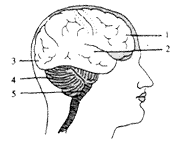
1. Frontal lobe of cerebrum
2. Temporal lobe of cerebrum
3. Occipital lobe of cerebrum
4.Cerebellum
5. Medulla oblongata
study the diagram and answer the following questions :
(I) What handicaps would result from :
i) damage to part numbered 3 ?
(ii) damage to part numbered 4 ?
(II) Mention one main function of each
of the parts numbered 1, 2and 5.
|
|
Ans.3 (b) 1 - Frontal lobe.
2 - Temporal lobe.
3 - Occipital lobe of cerebrum.
4 - Cerebellum.
5 - Medulla oblongata.
Ans. 3 (I)
(i) Damage to part 3 will disturb the vision.
(ii) Damage to cerebelum will disturb the posture and equillibrium .
(II)
PART 1 -It is concerned with the involuntary movements and autonomic
nervous system .
PART 2 - It is concerned with the sensory speach area .
PART 5- It regulates heart beat .
|
|
Q 4 (a) The following diagram represents a mammalian kidney
tubule and its blood supply. Parts indicated by the guidelines 1 to
8 are as follows :
1.U-shaped loop of Henle.
2. Proximal convoluted tubule with blood capilliaries
3.Bowman's capsule
4.Afferent arteriole from renal artery.
5. Glomerulus
6.Venule to renal vein
7.Collecting tubule
8. Distal convoluted tubule with blood capillaries
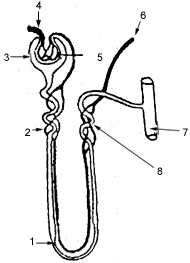
study the diagram and answer the following questions in each case
:
i)Where does ultrafiltration take place /
ii)Which structures contains the lowest concentration of
urea ?
iii)Which structures contains the highest concentration
of urea ?
iv)Which structures contains the lowest concentration of glucose
?
v)Where is the most water reabsorbed ?
Ans. 4 (a) (i)Ultra filteration takes place in the Bowman's capsule.
(ii) Proximal convoluted
tubule with blood capilleries
(iii) Glomerulus
(iv) Loop of Henle.
(v) Proximal convoluted
tubule with blood capillaries.
Q 4 (b) A well watered
healthy potted plant with variegated leaves was kept in darkness
for about 24 hours. It was then set up asshown in the diagram below
and exposed to light for about 12 hours. At the end of this time, leaf X
and leaf Y were tested for starch. Study the diagram and answer the
questions that follows :
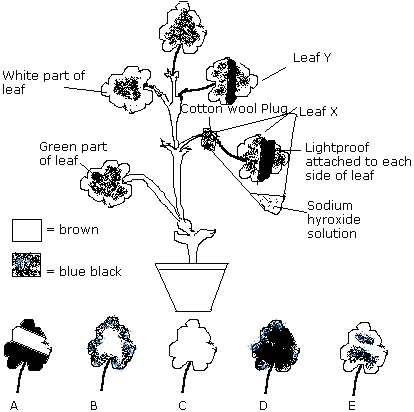
i) why was the plant
initially kept in darkness for 24 hours ?
ii) What is the function of sodium hydroxide solution in the flask ?
iii) select the correct leaf from the five available choices shown in the
diagram as A,B,C,D,and E . Rewrite the
correct answer by filling in the appropriate letter for the question that
follows :
1) After the starch test, leaf X would look like ..blue...............
2) After the starch test, leaf Y would look like....brown...........
iv) The experiment with leaf Y shows that photosynthesis requires the
presence of certain factors. Mention any one factor.
|
|
Ans. 4(b) (i) To remove all starch
(ii) Sodium hydroxide absorbs the Co2 present in air
(iii) The correct leaf is D
(iv) The photosynthesis requires the presense of
light in experiment with leaf y.
|
|
Q 5 (a) State one function of each of the following :
i) Ciliated epithelium lining the
respiratory tract
ii) Epiglottis
iii) Skin
iv) Mitochondria
v)Medulla Oblongata
Ans. 5 (a) (i) Function :- Cilia of the epithelium carry the mucus
containing dust particales upto the throat where from they can be spitted
out.
(ii) Function :- It is the leaf like flap
of glottis. It helps to open the glottis, So that air can enter inside the
larynx to produce energy.
(iii) Function :- Mitochondria acts as the
powerhouse of the cell. It helps to produce energy.
(iv) Function :- Skin checks the entry of
germs inside the body
(v) Function :- It controls the rate of
heart beat.
Q 5 (b) The following
diagram represents a plant cell after being placed in a strong
sugar solution . Guidelines 1 to 5 indicate the following :
1. Cell wall
2. Strong sugar solution
3. Protoplasm
4. Large vacuole
5. Nucleus
study the diagram and answer the
questions that follow :
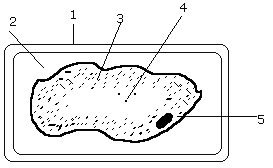
i)What is the state of the cell shown in
the diagram ?
ii)Name the structure which act as a
selectively permeable membrane.
iii) If the cell had been placed in
distilled water instead of strong sugar solution , which features would
not have been present ?
iv) If the cell in the diagram possessed
chloroplasts, where would these be present ?
v) Name any one feature
of this plant cell which is not present in animals cells.
|
|
Ans. 5 (b)(i) Cell shown Plasmolysis
(ii) Plasma membrane
(iv) Shrinkage of Protoplosm, or Plasmolysis would have been
present.
(iv) These cells would be present in leaves.
(v) Cell wall
|
|
Q 6 (a) The
diagram below shows part of the capillary bed in an organ of the mammalian
body. Some of the blood arriving at the capillaries at points
labelled. A moves out into the spaces between the tissue cells.
Study the diagram and answer the questions that follows :
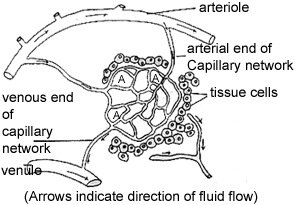
i) when the liquid
from the blood is surrounding the cells , what is it called ?
ii) Name any one
important component of the blood which remains inside the
capillaries and fails to move out into the spaces.
iii) Some of the liquid
surroundings the cells does not pass directly back into the blood but
eventually reaches it by another route through vessel X. Name the
fluid present in vessel X.
Ans. 6 (a) (i) Tissue fluid
(ii) W.B.C
(iii) Lymph
(iv) Functions of Lymph :- It plays a very
important role in providing immunity. It plays a vital role in transport
between cells, in diffusion etc.
Q 6 (b) Answer the
following questions :
i) Name the endocrine cells present in the Pancreas.
ii)Name two hormones secreted by the above mentioned
cells.
iii)Mention one main function of each
hormone named in (ii)
Ans. 6 (b) (i) Islets of Langerhans.
(ii) Glucagon and Insulin
(iii) Insulin :- regulates the blood sugar level by converting excess of
glycogen into the glucose.
Glucagon :- It increases the blood glucose level.
|
| Q 7 (a)The
figure given below represents the female reproductive system of a mammal.
Parts indicated by the guidelines A to D are as follows :
A. Uterus
B. Fallopian tube
C. Ovary
D. Vagina
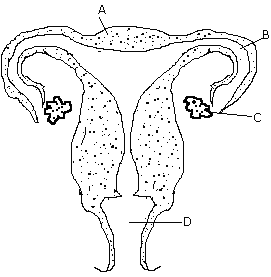
Give appropriate terms for
each of the following :
i)the cost of reproductive phase in a
young female
ii)Rupture of follicle and release of
ovum from the ovary.
iii)Monthly discharge of blood and
disintegerated tissues in human female
iv)Process of fusion of ovum and sperm
v)Fixing of developing zygote on the
uterine wall.
Ans. 7(a) (i) Puberty
(ii) Ovulation
(iii) Menstrual cycle
(iv) Fertilization
(v) Implantation
Q 7(b) Differentiate
between members of each of the following pairs with reference to the
phrases in brackets :
i)Osmosis and Diffusion (flow of solvent molecules)
ii) Myopia and hypermetropia (cause of the defect)
iii) Glycolysis and Kreb's cycle (Reaction site of the process in a cell)
iv) artery and vein (Direction of blood flow)
v) Aerobic and anaerobic respiration (End products of the process)
Ans. 7(b) (i) Osmosis :- It is the
movement of only solvent from its higher free energy to the area of its
fre energy. When the solute particles are not allowed to diffuse.
Diffussion : It is the movement of all
types of substances from the area of higher free energy to the area of
their lower free enegy.
(ii) Myopia :- In this eye defect, Person
has difficulty in seeing distant object clearly.
Hypermetropia :- In this eye defect the
person has difficulty in seeing near object.
(iii) Glycolysis :- It occurs in Cytoplasm.
Kreb's Cycle :-
occurs in Mitochondria in the presence of
Oxygen.
(iv) Artery :- The blood flows away from
heart.
Vein :- The blood flows towards the heart.
(v) Aerobic respiration :- End product is
CO2 and H2O.
Anaerobic respiration :- End product is CO2
and Alcohol.
|
|
|









